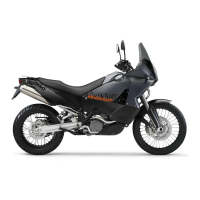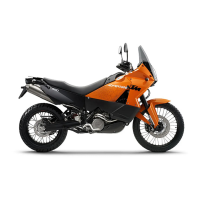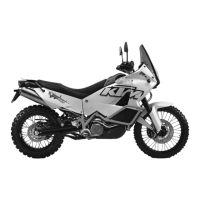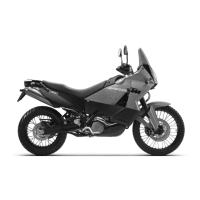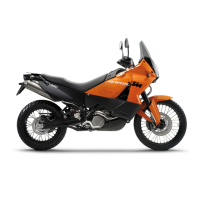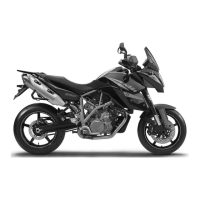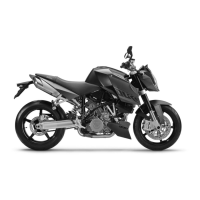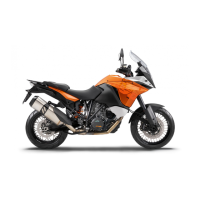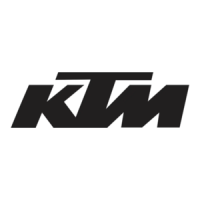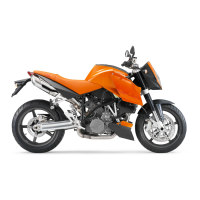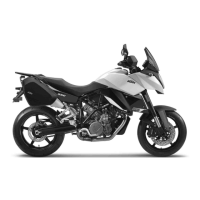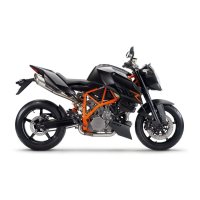Do you have a question about the KTM 990 ADVENTURE EU and is the answer not in the manual?
Defines the intended use of KTM sport motorcycles for road and light offroad operation.
Emphasizes proper service and care for optimal operation and prevention of premature wear.
Outlines conditions for warranty claims and voiding thereof due to modifications.
Recommends using approved KTM parts and accessories installed by authorized workshops.
Details rules for repairs, including special tools and part replacement.
Provides safety notes regarding vehicle transport to prevent damage or accidents.
Identifies components from the front left side view of the motorcycle.
Identifies components from the rear right side view of the motorcycle.
Explains the location and identification of the chassis number on the vehicle.
Details the location for finding the engine number on the motorcycle.
Explains the key number and the importance of the keycard for spare keys.
Details clutch lever, hand brake lever, light switch, and other handlebar controls.
Covers emergency OFF switch and electric starter button locations and functions.
Explains the various display modes and buttons of the combination instrument.
Covers speedometer, trip meters, ambient temperature, and warning indicators.
Details the socket for accessories and the hazard warning flasher switch.
Instructions on opening and closing the fuel filler caps safely.
Explains how to lock, unlock, open, and close the storage compartment.
Describes handrails, luggage rack plate, fuel taps, foot brake, and shift lever.
Covers the side stand, center stand, and passenger footrests.
Safety precautions for initial use, including tire break-in and handling.
Guidelines for engine break-in, including speed and load limits.
Advice on safe loading to maintain handling and prevent accidents.
Essential checks and maintenance measures to perform before every trip.
Procedure for safely starting the motorcycle's engine.
Guidance on starting from a standstill and shifting through gears.
Explains proper braking methods and potential hazards.
Instructions for safely stopping and parking the motorcycle.
Guidelines for safe and correct refueling of the motorcycle.
Details on adjusting compression, rebound damping, and spring preload for the fork.
Instructions for adjusting low-speed, high-speed compression, rebound, and spring preload.
Procedures for using the center stand to raise and lower the motorcycle.
Steps for bleeding and cleaning the fork legs.
How to check and adjust steering head bearing play for safe handling.
Instructions for removing and installing front side covers and radiator guards.
Procedures for removing and mounting the seat and storage compartment.
Steps for removing and installing the left fuel tank.
Guides for checking chain dirt, cleaning, and adjusting chain tension.
How to check wear on the chain, rear sprocket, and engine sprocket.
Procedures for adjusting clutch lever and checking hydraulic clutch fluid level.
Instructions for removing and installing right and standard underride guards.
Explains the ABS unit, sensors, function, and warning lamp.
Details on checking and adjusting the free travel of the hand brake lever.
How to check the thickness and wear limit of brake discs.
Procedure for checking and adding front brake fluid.
How to check the minimum thickness of front brake linings.
Checking and adjusting the free travel of the foot brake lever.
Procedure for checking and adding rear brake fluid.
How to check the minimum thickness of rear brake linings.
Step-by-step guide for removing and installing the front wheel.
Step-by-step guide for removing and installing the rear wheel.
Guidance on checking tire condition, tread depth, age, and potential hazards.
Recommended tire air pressure for solo and passenger/payload conditions.
How to check spoke tension by sound and correct if necessary.
Procedures for removing, installing, and recharging the battery.
Steps for locating and replacing the main fuse.
Instructions for replacing ABS hydraulic unit and return pump fuses.
How to change fuses located in the main fuse box.
Procedures for removing, installing, and changing headlight bulbs.
Process for activating or deactivating ignition keys using the programming key.
Steps to check coolant antifreeze protection and level in tank and radiator.
Detailed steps for filling and bleeding the cooling system to remove air.
How to check and top up the coolant level in the compensating tank.
Procedure for checking and topping up the engine oil level.
Steps for draining oil, cleaning screens, and changing the oil filter.
Detailed instructions for removing and installing the engine oil filter.
Guidance on how to add engine oil correctly in two steps.
Safe methods for cleaning the motorcycle, avoiding high pressure and direct sun.
Recommendations for protecting the motorcycle during winter operation with salt.
Actions to take when garaging the motorcycle for an extended period.
Steps to follow to get the motorcycle ready after a period of storage.
Addresses issues when the engine doesn't turn or starts incorrectly.
Covers causes and solutions for low power or overheating engine conditions.
Explains what warning lamps (FI, ABS) indicate and potential causes.
Troubleshooting for battery discharge or lack of charging.
Specifies the required quantities for engine oil and coolant.
Provides data on frame type, fork, and shock absorber models.
Details on front and rear brake systems, including discs.
Information on tire sizes, pressures, and capacities.
Specifications for all lighting components like low beam, high beam, etc.
Details DOT 4 and DOT 5.1 brake fluid types and recommendations.
Specifies coolant types, mixture ratios, and antifreeze protection.
Recommends SAE viscosity grades and types for engine oil.
Lists recommended oils for fork and shock absorber.
Specifies hydraulic fluid type and unleaded fuel requirements.
Defines the intended use of KTM sport motorcycles for road and light offroad operation.
Emphasizes proper service and care for optimal operation and prevention of premature wear.
Outlines conditions for warranty claims and voiding thereof due to modifications.
Recommends using approved KTM parts and accessories installed by authorized workshops.
Details rules for repairs, including special tools and part replacement.
Provides safety notes regarding vehicle transport to prevent damage or accidents.
Identifies components from the front left side view of the motorcycle.
Identifies components from the rear right side view of the motorcycle.
Explains the location and identification of the chassis number on the vehicle.
Details the location for finding the engine number on the motorcycle.
Explains the key number and the importance of the keycard for spare keys.
Details clutch lever, hand brake lever, light switch, and other handlebar controls.
Covers emergency OFF switch and electric starter button locations and functions.
Explains the various display modes and buttons of the combination instrument.
Covers speedometer, trip meters, ambient temperature, and warning indicators.
Details the socket for accessories and the hazard warning flasher switch.
Instructions on opening and closing the fuel filler caps safely.
Explains how to lock, unlock, open, and close the storage compartment.
Describes handrails, luggage rack plate, fuel taps, foot brake, and shift lever.
Covers the side stand, center stand, and passenger footrests.
Safety precautions for initial use, including tire break-in and handling.
Guidelines for engine break-in, including speed and load limits.
Advice on safe loading to maintain handling and prevent accidents.
Essential checks and maintenance measures to perform before every trip.
Procedure for safely starting the motorcycle's engine.
Guidance on starting from a standstill and shifting through gears.
Explains proper braking methods and potential hazards.
Instructions for safely stopping and parking the motorcycle.
Guidelines for safe and correct refueling of the motorcycle.
Details on adjusting compression, rebound damping, and spring preload for the fork.
Instructions for adjusting low-speed, high-speed compression, rebound, and spring preload.
Procedures for using the center stand to raise and lower the motorcycle.
Steps for bleeding and cleaning the fork legs.
How to check and adjust steering head bearing play for safe handling.
Instructions for removing and installing front side covers and radiator guards.
Procedures for removing and mounting the seat and storage compartment.
Steps for removing and installing the left fuel tank.
Guides for checking chain dirt, cleaning, and adjusting chain tension.
How to check wear on the chain, rear sprocket, and engine sprocket.
Procedures for adjusting clutch lever and checking hydraulic clutch fluid level.
Instructions for removing and installing right and standard underride guards.
Explains the ABS unit, sensors, function, and warning lamp.
Details on checking and adjusting the free travel of the hand brake lever.
How to check the thickness and wear limit of brake discs.
Procedure for checking and adding front brake fluid.
How to check the minimum thickness of front brake linings.
Checking and adjusting the free travel of the foot brake lever.
Procedure for checking and adding rear brake fluid.
How to check the minimum thickness of rear brake linings.
Step-by-step guide for removing and installing the front wheel.
Step-by-step guide for removing and installing the rear wheel.
Guidance on checking tire condition, tread depth, age, and potential hazards.
Recommended tire air pressure for solo and passenger/payload conditions.
How to check spoke tension by sound and correct if necessary.
Procedures for removing, installing, and recharging the battery.
Steps for locating and replacing the main fuse.
Instructions for replacing ABS hydraulic unit and return pump fuses.
How to change fuses located in the main fuse box.
Procedures for removing, installing, and changing headlight bulbs.
Process for activating or deactivating ignition keys using the programming key.
Steps to check coolant antifreeze protection and level in tank and radiator.
Detailed steps for filling and bleeding the cooling system to remove air.
How to check and top up the coolant level in the compensating tank.
Procedure for checking and topping up the engine oil level.
Steps for draining oil, cleaning screens, and changing the oil filter.
Detailed instructions for removing and installing the engine oil filter.
Guidance on how to add engine oil correctly in two steps.
Safe methods for cleaning the motorcycle, avoiding high pressure and direct sun.
Recommendations for protecting the motorcycle during winter operation with salt.
Actions to take when garaging the motorcycle for an extended period.
Steps to follow to get the motorcycle ready after a period of storage.
Addresses issues when the engine doesn't turn or starts incorrectly.
Covers causes and solutions for low power or overheating engine conditions.
Explains what warning lamps (FI, ABS) indicate and potential causes.
Troubleshooting for battery discharge or lack of charging.
Specifies the required quantities for engine oil and coolant.
Provides data on frame type, fork, and shock absorber models.
Details on front and rear brake systems, including discs.
Information on tire sizes, pressures, and capacities.
Specifications for all lighting components like low beam, high beam, etc.
Details DOT 4 and DOT 5.1 brake fluid types and recommendations.
Specifies coolant types, mixture ratios, and antifreeze protection.
Recommends SAE viscosity grades and types for engine oil.
Lists recommended oils for fork and shock absorber.
Specifies hydraulic fluid type and unleaded fuel requirements.
| Displacement | 999 cc |
|---|---|
| Compression Ratio | 11.5:1 |
| Torque | 100 Nm |
| Cooling | Liquid cooled |
| Transmission | 6-speed |
| Starter | Electric starter |
| Front Tire | 90/90-21 |
| Rear Tire | 150/70-18 |
| Engine Type | V-twin, 4-stroke |
| Bore x stroke | 101 mm x 62.4 mm |
| Fuel System | Electronic fuel injection |
| Frame | Chromium-Molybdenum steel trellis frame, powder coated |
| Front Suspension | WP Ø 48 mm |
| Rear Suspension | Monoshock |
| Rear Brake | Single 240 mm disc, 2-piston caliper |
| ABS | Optional |
| Fuel Capacity | 22 liters |
| Power | 114 hp (85 kW) @ 9, 000 rpm |
| Front Brake | Dual 300 mm discs, 4-piston calipers |
